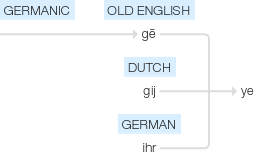Ye
Old English gē, of Germanic origin; related to Dutch gij and German ihr .
wiktionary
From Middle English ye, ȝe, from Old English ġē(“ye”), the nominative case of the second-person plural personal pronoun, from Proto-West Germanic *jiʀ, from Proto-Germanic *jīz, a North-West variant of Proto-Germanic *jūz(“ye”), from Proto-Indo-European *yūs, *yū́(“ye”), plural of *túh₂. Cognate with Scots ye(“ye”), Saterland Frisian jie, Dutch gij, jij, je(“ye”), Low German ji, jie(“ye”), German ihr(“ye”), Danish and Swedish I(“ye”), Icelandic ér(“ye”). See also you.
From Middle English þe. Early press typographies lacked the letter þ(“thorn”), for which the letter y was substituted due to their resemblance in blackletter hand (etymological y was for a while distinguished by a dot, ẏ). Short form yͤ continued long after the digraph th had replaced þ elsewhere.
Shortened from yes or yeah.
From Russian е(je).
etymonline
ye (pron.)
Old English ge, nominative plural of 2nd person pronoun þu (see thou); cognate with Old Frisian ji, Old Saxon gi, Middle Dutch ghi, Dutch gij. Cognate with Lithuanian jūs, Sanskrit yuyam, Avestan yuzem, Greek hymeis.
Altered, by influence of we, from an earlier form that was similar to Gothic jus "you (plural)" (see you). The -r- in Old Norse er, German ihr probably is likewise from influence of their respective 1st person plural pronouns (Old Norse ver, German wir).
ye (article)
old or quaintly archaic way of writing the, in which the -y- is a 16c. graphic alteration of þ, an Old English character (generally called "thorn," originally a Germanic rune; see th) that represented the -th- sound (as at the beginning of thorn). The characters for -y- and -þ- so closely resembled each other in Old English and early Middle English handwriting that a dot had to be added to the -y- to keep them distinct. In late 15c., early printers in English, whose types were founded on the continent, did not have a þ in their sets, so they substituted y as the letter that looked most like it when setting type. But in such usages it was not meant to be pronounced with any of the sounds associated with -y-, but still as "-th-." Ye for the (and yt for that) continued in manuscripts through 18c. Revived 19c. as a deliberate antiquarianism; the Ye Olde _____ construction was being mocked by 1896.
